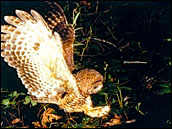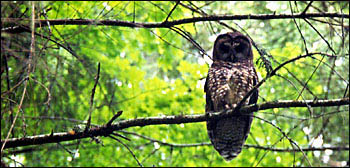

 Deep
in the forests of the Pacific Northwest, lives a nocturnal
carnivore of unparalleled repute. Some say they’ve seen it swoop
down on its victims in the dead of night and feast on the bodies among
the branches of knotted, old trees. Others say its haunting call can be
heard from a mile away. The mere mention of the creature’s name
brings shudders to loggers and some local inhabitants. Fear over its
existence has incited rallies, garnered the attention of three
government agencies, and caused people to tie themselves to trees. |
 Flying squirrels and wood rats are a spotted owl's favorite prey. (Photograph courtesy Jerry Mires) | |
 To
scientists this animal is known as Strix occidentalis caurina, but
it is commonly referred to as the northern spotted owl. For more than
ten years environmental groups and logging corporations spent millions
of dollars in attempts to control the fate of the bird’s old-growth
forest habitat. Hardly a week went by in the late 1980s where there
wasn’t a story about a protest rally attempting to save the owl or
news of lawsuits being filed to stop the harvest of the owl’s
habitat. |
A northern spotted owl at home in the old-growth forests of the Pacific Northwest. As part of the plan to protect the spotted owl, biologists and land managers are using satellites to map potential habitat. (Photograph courtesy Janice Reid) | |
| At the end of the decade the U.S. Fish and Wildlife Service put the
owl on the Federal Threatened Species List, and the federal government
devised a strategy to conserve the old-growth forests in western Oregon,
Washington, and Northern California. While these government actions
quelled the conflict between loggers and environmentalists, they created
a whole new set of challenges for the scientists studying the owl’s
habitat. The problem was that no one in the state or federal governments
had a way to determine how many birds or how much old-growth forest
existed in an area as vast as that specified by the government plan. For
four years scientists from three government agencies toiled over a
number of approaches.
Earlier this year a method to monitor the owls was finally decided on. With the help of Landsat 5 and the newly-launched Landsat 7, researchers plan to locate areas where owls are likely to live. They will then use this information, along with ground surveys, to map out the owl’s habitat and create a method for assessing the health of the owl population in the Pacific Northwest. Whether this strategy will succeed remains to be seen.
The data used in this study are available in one or more of NASA's Earth Science Data Centers. |
 Because of the link between spotted owls and undisturbed forest, the threatened birds have been caught up in the conflict between environmentalists and the timber industry. (Photograph courtesy Sierra Club) |